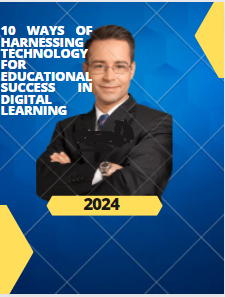
10 Ways of Harnessing Technology for Educational Success in Digital Learning in 2024
Overview Computerized learning has arisen as a progressive power in the rapidly changing instructive scene, changing how understudies cooperate with content, access data, and work along with cohorts. We should discuss 10 Methods for involving Innovation for Your Potential benefit in Computerized Learning
1. Acquiring Worldwide Assets Digital learning removes geographical barriers and provides students with unparalleled access to numerous international resources. Through online platforms, access to research papers, instructional materials, and interactive content from experts and institutions around the world can enhance students’ learning experiences.
2. Content that is Intuitive and Locking in Technology makes it possible to create dynamic and interactive educational resources. Computerized devices, as programmatic experiences and sight and sound introductions, connect with understudies in manners that more established methods wouldn’t. The learning process is made more enjoyable and efficient by gamified elements and interactive tests.
3. Versatility and Accessibility There is adaptability in advanced getting the hang of in regards to the overall setting at which understudies can get to course materials. With the notoriety of online schooling and virtual homerooms, understudies may now modify their review intends to accommodate their one of a kind learning inclinations and paces.
4. Platforms for Learning in Teams Students can participate in group projects, peer reviews, and conversations on collaborative learning platforms made possible by advancements in technology. This makes a sensation of local area and advances helpful critical thinking, which is like the way that collaboration is habitually required in genuine circumstances.
5. Individualized Educational Trips Digital learning systems use data analytics to tailor the learning paths of students. Instructive applications that utilization versatile learning frameworks can decide the qualities and shortcomings of every client and alter content to address their issues, making learning more successful and individualized.
6. Utilizing EdTech Apparatuses to Foster Abilities Different instructive innovation apparatuses plan to work on specific abilities. Through language learning applications and coding stages, children can acquire helpful abilities that are turning out to be increasingly more significant in the advanced time. This helps students succeed scholastically and prepares them for future business possibilities.
7. Quick Assessment and Info Real-time feedback and assessment systems can be implemented more easily thanks to digital learning. Instructors can survey understudies’ advancement rapidly with online tests and tasks, considering prompt remediation when fundamental. Students gain a clear understanding of their progress and learn more effectively when they receive immediate feedback.
8. Asset enhancement and cost-viability Digital tools can help lower the cost of education. By decreasing the interest for customary materials, advanced course books, online talks, and virtual study halls can further develop openness and maintainability in schooling. In circumstances where there may not be as much physical infrastructure, this is especially crucial.
9. Open doors for Proficient Turn of events Advanced learning enjoys benefits for instructors too. Educators can exploit opportunities for progressing proficient improvement through online courses, online courses, and virtual meetings. This ensures that educators stay in the know regarding the latest advancements in innovation and teaching method, subsequently working on the norm of guidance.
10. Moving beyond Learning Hindrances Training obstacles might be taken out with the utilization of computerized learning. In areas where traditional educational resources are scarce, online platforms can serve as a bridge, democratizing access and providing opportunities to a diverse range of students, including those with disabilities.
With such countless benefits that go past regular study hall settings, computerized learning is a strong driver for scholarly achievement.
Leave a Reply